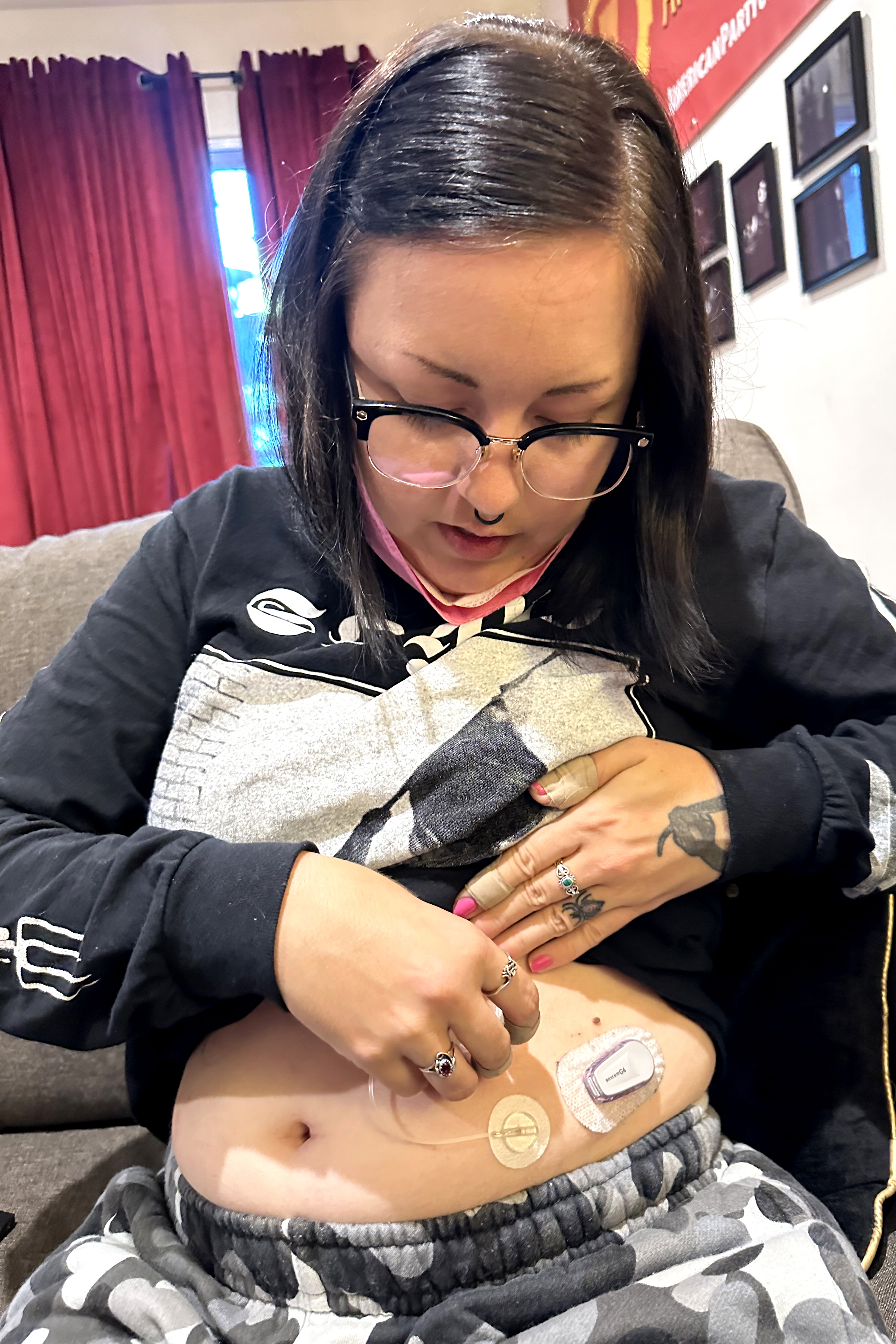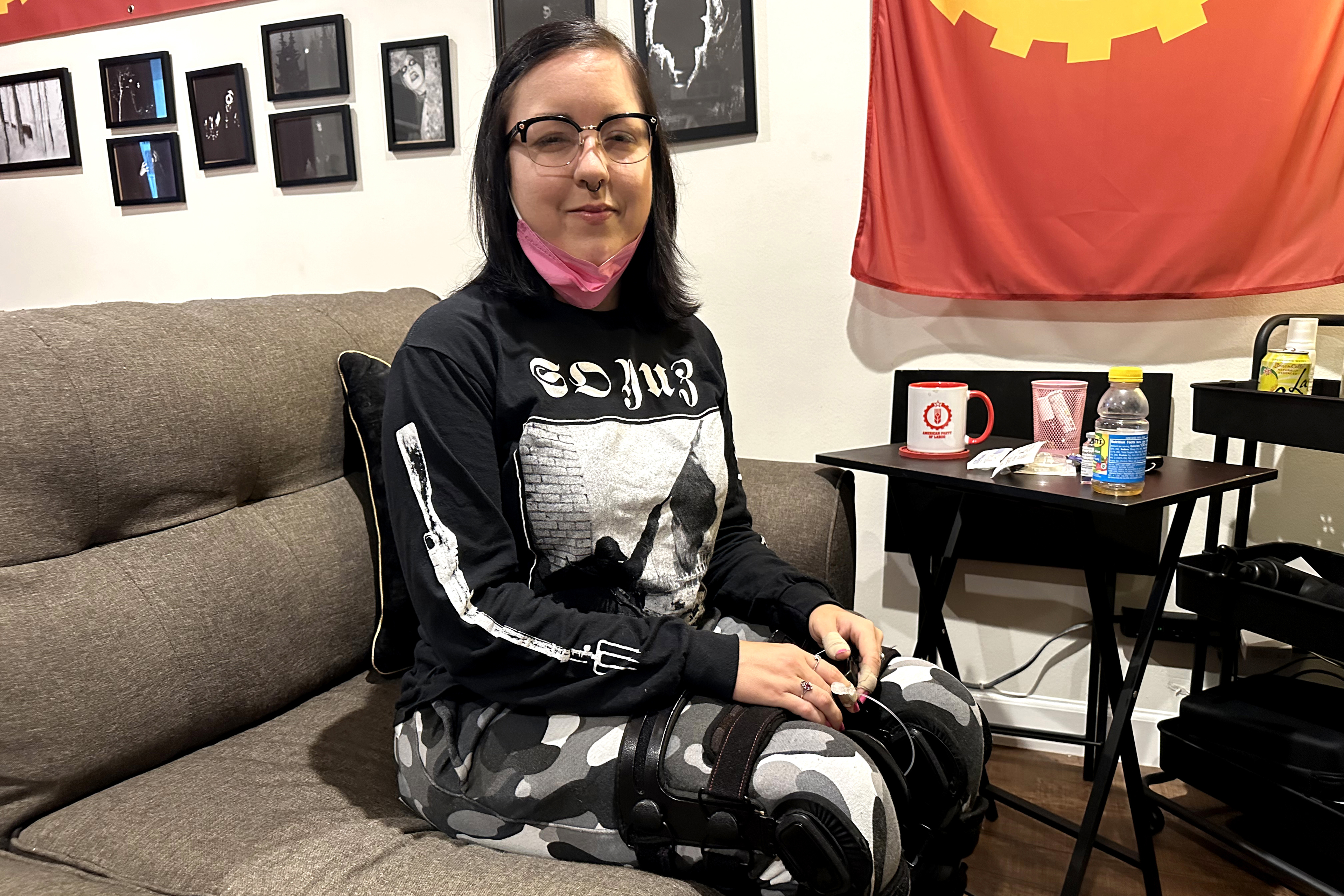[ad_1]
LOS ANGELES — June Voros sprang from her sofa as a high-pitched beep warned her that she wanted a fast dose of sugar.
Her blood sugar was plummeting, and the beep got here from a steady glucose monitor connected to her stomach. The small however highly effective machine alerts Voros when her blood sugar is dangerously excessive or low.
“My blood sugar is at 64. It’s too low and nonetheless dropping,” Voros, 32, mentioned on a vivid October afternoon. She checks the monitor as much as 80 occasions a day to assist forestall issues from Sort 1 diabetes.
However the monitor means little with out the provides that make it work, together with a receiver, a sensor, and a transmitter — a few of which should be changed each 10 to 30 days. Voros additionally has an insulin pump, which delivers a gentle provide of that hormone to her physique, and it requires provides too.
Till lately, Voros — who is roofed by Medi-Cal, California’s Medicaid program for folks with low incomes or disabilities — spent numerous hours on the cellphone together with her endocrinologists, her Medi-Cal insurer Well being Internet, and a medical provide firm to acquire separate approvals for every merchandise. At occasions, her authorizations expired too shortly, leaving her quick on provides and forcing her to ration and search donations on social media from different diabetes sufferers.
Final 12 months, she acquired solely sufficient provides to final six months.
“I’ve needed to put in a whole bunch of hours over the cellphone up to now few years, and I’ve modified my insurance coverage group twice due to this,” Voros mentioned earlier than slugging apple juice in her studio house within the Mission Hills neighborhood, a suburban neighborhood within the San Fernando Valley. “It’s exhausting. It makes you need to quit. However I can’t. I’ll actually die.”


Beginning in October, Medi-Cal started stress-free prior authorization necessities which have triggered life-threatening delays for Voros and others with diabetes.
Beforehand, authorizations for medicines and provides lasted six months, although for some sufferers, like Voros, they expired sooner. Underneath the brand new guidelines, authorizations are imagined to final one 12 months from the date of approval and may embody all wanted provides — ending the scramble to safe separate authorizations for each bit of kit. Sufferers can obtain 90 days’ value of provides and medicines without delay.
The state can be formalizing a coverage that permits sufferers to acquire approvals from their well being care suppliers by cellphone or video.
“Earlier than, California’s necessities have been 4 pages lengthy, and now it’s just a bit greater than a web page,” mentioned Lisa Murdock, chief advocacy officer for the American Diabetes Affiliation, who helped push for the modifications. “This can be a actually essential step ahead. It means not having to continually guess how blood sugars are doing.”
Over the previous two years, the state additionally began making steady glucose displays and associated provides out there to many extra folks, together with all sufferers with Sort 1 diabetes, a power autoimmune illness that assaults insulin-producing cells within the pancreas, and people with Sort 2 diabetes, gestational diabetes, and hypoglycemia, or power low blood sugar. Earlier than final 12 months, the displays have been out there to just some sufferers on a case-by-case foundation, based on the state Division of Well being Care Providers, which administers Medi-Cal.
The improved protection extends to newer, extra superior gadgets, equivalent to the favored Dexcom G7 and its elements, which retail for about $700 on Amazon for a 30-day provide with out insurance coverage. Medi-Cal pays roughly $400 for a similar gear.
Diabetes and prediabetes are on the rise in California. About 3.2 million Californians have been identified with diabetes. The Division of Well being Care Providers says about 1.2 million Medi-Cal enrollees have the illness, based on the newest knowledge out there.

Earlier than these modifications, Medi-Cal recipients had a more durable time securing medicine and provides than folks with personal insurance coverage, Murdock mentioned.
“Diabetes is a very heartbreaking and dear illness, and to care for themselves, folks with diabetes want quick access to insulin, but additionally the provides to handle the illness,” she mentioned.
Affected person advocates and state well being officers say the modifications will lower your expenses and lives by giving these with diabetes extra management over their blood sugar, and by stopping issues equivalent to organ failure and foot and toe amputations.
This growth in protection “improves entry and member outcomes, reduces hospitalizations and comorbidities, and improves members’ high quality of life with higher illness administration and fewer finger sticks,” mentioned Ann Carroll, a Medi-Cal spokesperson. The state, she mentioned, needs to make sure all diabetes sufferers get “the care they should lead wholesome, fulfilling lives.”
Earlier than Voros bought her monitor about three years in the past, she needed to go to an emergency room repeatedly for seizures and was hospitalized with different diabetic issues. She additionally misplaced nerve perform in her abdomen — which prevents digestion of high-fiber meals like greens — as her illness superior.
“I haven’t needed to go to the intensive care unit in virtually two years. It has actually saved my life,” she mentioned.
However the bureaucratic hurdles that stored Voros from getting provides for her monitor have been a continuing supply of stress. That’s altering since she switched to a brand new medical provide firm and Medi-Cal has debuted its new preauthorization course of, amid a broader revamp of its pharmacy system.
Getting her provides on time means peace of thoughts, Voros mentioned.
“I was so afraid to fall asleep at evening due to the seizures I’d get from low blood sugar,” she mentioned. “I’ve been actually near demise, however now I really feel higher than I ever have.”
This text is a part of “Faces of Medi-Cal,” a California Healthline sequence exploring the affect of the state’s safety-net well being program on enrollees.
This text was produced by KFF Well being Information, which publishes California Healthline, an editorially impartial service of the California Well being Care Basis.
[ad_2]


